Thermal Maturity of the Silurian “Hot” Shales and Correlation with the Present Geothermal Variations in West Lithuania, Baltic Basin
Abstract
1. Introduction
2. Petroleum Play of the Baltic Basin
3. Materials and Methods
4. Results
4.1. Organic Petrography
4.2. Rock-Eval Analysis
5. Discussion
5.1. Control on Kerogen Type and Quality
5.2. Thermal Maturity
6. Conclusions
Supplementary Materials
Author Contributions
Funding
Institutional Review Board Statement
Data Availability Statement
Acknowledgments
Conflicts of Interest
References
- Barker, C.E.; Pawlewicz, M.J. Calculation of Vitrinite Reflectance from Thermal Histories and Peak Temperature: A Comparison of Methods. In Vitrinite Reflectance as a Maturity Parameter; ACS Publications: Washington, DC, USA, 1994. [Google Scholar]
- Kowalska, S.; Wójtowicz, A.; Hałas, S.; Wemmer, K.; Mikołajewski, Z. Thermal History of Lower Palaeozoic Rocks from the East European Platform Margin of Poland Based on K-Ar Age Dating and Illite-Smectite Palaeothermometry. In Annales Societatis Geologorum Poloniae; Polskie Towarzystwo Geologiczne: Kraków, Poland, 2019. [Google Scholar] [CrossRef]
- Derkowski, A.; Środoń, J.; Goryl, M.; Marynowski, L.; Szczerba, M.; Mazur, S. Long-distance Fluid Migration Defines the Diagenetic History of Unique Ediacaran Sediments in the East European Craton. Basin Res. 2021, 33, 570–593. [Google Scholar] [CrossRef]
- Peters, K.E.; Cassa, M.R. Applied Source Rock Geochemistry: Chapter 5: Part II. In Essential Elements; Hal Leonard Corporation: Milwaukee, WI, USA, 1994. [Google Scholar]
- Schovsbo, N.H.; Moron, J.M.; Nielsen, A.T.; Nicolas, G.; Petersen, H.I.; Stouge, S. Thermal Maturity of Lower Palaeozoic Shales in North-West Europe—Calibration of Proxies. In Proceedings of the 74th EAGE Conference and Exhibition Incorporating EUROPEC 2012, Copenhagen, Denmark, 4–7 June 2012. [Google Scholar]
- Misra, S.; Das, S.K.; Varma, A.K.; Mani, D.; Kalpana, M.S.; Ekblad, A.; Biswas, S. Multi-Proxy Approach on the Hydrocarbon Generation Perspective of Barjora Basin, India. Mar. Pet. Geol. 2020, 112, 104108. [Google Scholar] [CrossRef]
- Spina, A.; Cirilli, S.; Sorci, A.; Schito, A.; Clayton, G.; Corrado, S.; Fernandes, P.; Galasso, F.; Montesi, G.; Pereira, Z.; et al. Assessing Thermal Maturity through a Multi-Proxy Approach: A Case Study from the Permian Faraghan Formation (Zagros Basin, Southwest Iran). Geosciences 2021, 11, 484. [Google Scholar] [CrossRef]
- Majorowicz, J.A.; Marek, S.; Znosko, J. Palaeogeothermal Gradients by Vitrinite Reflectance Data and Their Relation to the Present Geothermal Gradient Patterns of the Polish Lowland. Tectonophysics 1984, 103, 141–156. [Google Scholar] [CrossRef]
- Poprawa, P. Shale Gas Potential of the Lower Palaeozoic Complex in the Baltic and Lublin-Podlasie Basins (Poland). Przegląd Geol. 2010, 58, 226–249. [Google Scholar]
- Jarzyna, J.A.; Bała, M.; Krakowska, P.I.; Puskarczyk, E.; Strzępowicz, A.; Wawrzyniak-Guz, K.; Więcław, D.; Ziętek, J. Shale Gas in Poland. In Advances in Natural Gas Emerging Technologies; Al-Megren, H.A., Altamimi, R.H., Eds.; InTech: London, UK, 2017; ISBN 978-953-51-3433-6. [Google Scholar]
- Kadūnienė, E. Organic Matter in Oil Source Rocks. In Petroleum Geology of Lithuania and Southeastern Baltic; Institute of Geology: Vilnius, Lithuania, 2001; pp. 96–119. ISBN 978-9986-615-23-1. [Google Scholar]
- Zdanavičiūte, O.; Sakalauskas, K. Petroleum Geology of Lithuania and Southeastern Baltic; Institute of Geology: Vilnius, Lithuania, 2001; ISBN 978-9986-615-23-1. [Google Scholar]
- Šliaupa, S.; Lozovskis, S.; Lazauskienė, J.; Šliaupienė, R. Petrophysical and Mechanical Properties of the Lower Silurian Perspective Oil/Gas Shales of Lithuania. J. Nat. Gas Sci. Eng. 2020, 79, 103336. [Google Scholar] [CrossRef]
- Cichon-Pupienis, A.; Littke, R.; Froidl, F.; Lazauskienė, J. Depositional History, Source Rock Quality and Thermal Maturity of Upper Ordovician—Lower Silurian Organic-Rich Sedimentary Rocks in the Central Part of the Baltic Basin (Lithuania). Mar. Pet. Geol. 2020, 112, 104083. [Google Scholar] [CrossRef]
- Soua, M. Paleozoic Oil/Gas Shale Reservoirs in Southern Tunisia: An Overview. J. Afr. Earth Sci. 2014, 100, 450–492. [Google Scholar] [CrossRef]
- Luening, S.; Shahin, Y.M.; Loydell, D.; Al-Rabi, H.T.; Masri, A.; Tarawneh, B.; Kolonic, S. Anatomy of a World-Class Source Rock: Distribution and Depositional Model of Silurian Organic-Rich Shales in Jordan and Implications for Hydrocarbon Potential. Bulletin 2005, 89, 1397–1427. [Google Scholar] [CrossRef]
- Zaixing, J.; Ling, G.; Chao, L.; Yuan, W.; Min, L. Lithofacies and Sedimentary Characteristics of the Silurian Longmaxi Shale in the Southeastern Sichuan Basin, China. J. Palaeogeogr. 2013, 2, 238–251. [Google Scholar]
- Wang, X.; Zhu, Y.; Lash, G.G.; Wang, Y. Multi-Proxy Analysis of Organic Matter Accumulation in the Upper Ordovician–Lower Silurian Black Shale on the Upper Yangtze Platform, South China. Mar. Pet. Geol. 2019, 103, 473–484. [Google Scholar] [CrossRef]
- Jiang, S.; Peng, Y.; Gao, B.; Zhang, J.; Cai, D.; Xue, G.; Bao, S.; Xu, Z.; Tang, X.; Dahdah, N. Geology and Shale Gas Resource Potentials in the Sichuan Basin, China. Energy Explor. Exploit. 2016, 34, 689–710. [Google Scholar] [CrossRef]
- Boote, D.R.D.; Clark-Lowes, D.D.; Traut, M.W. Palaeozoic Petroleum Systems of North Africa. Geol. Soc. Lond. Spec. Publ. 1998, 132, 7–68. [Google Scholar] [CrossRef]
- Luening, S.; Craig, J.; Loydell, D.K.; Štorch, P.; Fitches, B. Lower Silurian ‘hot Shales’ in North Africa and Arabia: Regional Distribution and Depositional Model. Earth-Sci. Rev. 2000, 49, 121–200. [Google Scholar] [CrossRef]
- Welte, D.H.; Horsfield, B.; Baker, D.R. Petroleum and Basin Evolution: Insights from Petroleum Geochemistry, Geology and Basin Modeling; Springer: Berlin/Heidelberg, Germany, 1997; ISBN 978-3-540-61128-8. [Google Scholar]
- Nehring-Lefeld, M.; Modliński, Z.; Swadowska, E. Thermal Evolution of the Ordovician in the Western Margin of the East-European Platform: CAl and Ro Data. Geol. Q. 1997, 41, 129–138. [Google Scholar]
- Skret, U.; Fabianska, M.J. Geochemical Characteristics of Organic Matter in the Lower Palaeozoic Rocks of the Peribaltic Syneclise (Poland). Geochem. J. 2009, 43, 343–369. [Google Scholar] [CrossRef]
- Urban, G. Нoвые Определения Теплoвoгo Пoтoка в Пределах Теплoвoй Анoмалии Балтийскoй Синеклизы. Proc. Est. Acad. Sci. Geol. 1991, 40, 24–32. [Google Scholar] [CrossRef]
- Zajacs, A.; Shogenova, A.; Shogenov, K.; Volkova, A.; Sliaupa, S.; Sliaupiene, R.; Jõeleht, A. Utilization of Geothermal Energy: New Possibilities for District Heating Networks in the Baltic States. Renew. Energy 2025, 242, 122375. [Google Scholar] [CrossRef]
- Motuza, G. The Precambrian Geology of Lithuania: An Integratory Study of the Platform Basement Structure and Evolution; Regional Geology Reviews; Springer International Publishing: Cham, Switzerland, 2022; ISBN 978-3-030-96854-0. [Google Scholar]
- Paškevičius, J. The Geology of the Baltic States; Geological Survey of Lithuania: Vilnius, Lithuania, 1997; ISBN 978-9986-623-20-5. [Google Scholar]
- Nikishin, A.M.; Ziegler, P.A.; Stephenson, R.A.; Cloetingh, S.A.P.L.; Furne, A.V.; Fokin, P.A.; Ershov, A.V.; Bolotov, S.N.; Korotaev, M.V.; Alekseev, A.S.; et al. Late Precambrian to Triassic History of the East European Craton: Dynamics of Sedimentary Basin Evolution. Tectonophysics 1996, 268, 23–63. [Google Scholar] [CrossRef]
- Pharaoh, T.C.; Winchester, J.A.; Verniers, J.; Lassen, A.; Seghedi, A. The Western Accretionary Margin of the East European Craton: An Overview. Memoirs 2006, 32, 291–311. [Google Scholar] [CrossRef]
- Ponikowska, M.; Stovba, S.M.; Mazur, S.; Malinowski, M.; Krzywiec, P.; Nguyen, Q.; Hübscher, C. Crustal Structure and Tectonic Evolution of the Southern Baltic Sea Interpreted from Seismic, Gravity and Magnetic Data. ESS Open Archive 2023. [Google Scholar] [CrossRef]
- De Vos, W.; Hagen, F.; Tim, P.; Smith, N.; Vejbaek, O.; Verniers, J.; Nawrocki, J.; Poprawa, P.; Belka, Z. Pre-Devonian, Petroleum Geological Atlas of the Southern Permian Basin Area. In Petroleum Geological Atlas of the Southern Permian Basin Area; EAGE Publications: Dubai, United Arab Emirates, 2010; pp. 58–69. [Google Scholar]
- Pikulski, L.; Karnkowski, P.H.; Wolnowski, T. Petroleum Geology of the Polish Part of the Baltic Region-an Overview. Geol. Q. 2010, 54, 143–158. [Google Scholar]
- Okhotnikova, E.S.; Yusupova, T.N.; Barskaya, E.E.; Ganeeva, Y.M.; Mukhametshin, R.Z. Geochemical Analysis of Crude Oils in Kaliningrad Oblast Oil Fields and Its Importance for Oil Production. Pet. Chem. 2021, 61, 994–1001. [Google Scholar] [CrossRef]
- Domźalski, J.; Górecki, W.; Mazurek, A.; Myśko, A.; Strzetelski, W.; Szamałek, K. The Prospects for Petroleum Exploration in the Eastern Sector of Southern Baltic as Revealed by Sea Bottom Geochemical Survey Correlated with Seismic Data. Przegląd Geol. 2004, 52, 792–799. [Google Scholar]
- Kotarba, M.J. Origin of Hydrocarbon Gases Accumulated in the Middle Cambrian Reservoirs of the Polish Part of the Baltic Region. Geol. Q. 2010, 54, 197–204. [Google Scholar]
- Warwel, A.; Hübscher, C.; Hartge, M.; Artschwager, M.; Schäfer, W.; Preine, J.; Häcker, T.; Strehse, V.; Karušs, J.; Lüdmann, T. The Paleozoic Hydrocarbon System in the Gotland Basin (Central Baltic Sea) Leaks. Earth Space Sci. 2023, 10, e2023EA002883. [Google Scholar] [CrossRef]
- Laškovas, J. The Sedimentation Environments of the Ordovician Basin in the South-Western Margin of the East European Platform and Lithogenesis of Deposits; Institute of Geology: Vilnius, Lithuania, 2000. [Google Scholar]
- Yang, S.; Schulz, H.-M.; Schovsbo, N.H.; Bojesen-Koefoed, J.A. Oil–Source-Rock Correlation of the Lower Paleozoic Petroleum System in the Baltic Basin (Northern Europe). Bulletin 2017, 101, 1971–1993. [Google Scholar] [CrossRef]
- Lapinskas, P. Structure and Petroliferosity of the Silurian in Lithuania; Institute of Geology: Vilnius, Lithuania, 2000. [Google Scholar]
- Lazauskiene, J.; Sliaupa, S.; Brazauskas, A.; Musteikis, P. Sequence Stratigraphy of the Baltic Silurian Succession: Tectonic Control on the Foreland Infill. Geol. Soc. Lond. Spec. Publ. 2003, 208, 95–115. [Google Scholar] [CrossRef]
- Bičkauskas, G.; Molenaar, N. The Nature of the So-Called ‘Reefs’ in the Pridolian Carbonate System of the Silurian Baltic Basin. Geologija 2008, 50, 94–104. [Google Scholar] [CrossRef]
- Kaminskas, D.; Michelevičius, D.; Blažauskas, N. New Evidence of an Early Pridoli Barrier Reef in the Southern Part of the Baltic Silurian Basin Based on Three-Dimensional Seismic Survey, Lithuania. Estonian J. Earth Sci. 2015, 64, 47. [Google Scholar] [CrossRef]
- Zdanaviciute, O.; Bojesen-Koefoed, J.A. Geochemistry of Lithuanian oils and source rocks: A preliminary assessment. J. Pet. Geol. 1997, 20, 381–402. [Google Scholar] [CrossRef]
- Zdanaviciute, O.; Lazauskiene, J. The Petroleum Potential of the Silurian Succession in Lithuania. J. Pet. Geol. 2007, 30, 325–337. [Google Scholar] [CrossRef]
- Šliaupa, S.; Hoth, P. Geological Evolution and Resources of the Baltic Sea Area from the Precambrian to the Quaternary. In The Baltic Sea Basin; Harff, J., Björck, S., Hoth, P., Eds.; Central and Eastern European Development Studies (CEEDES); Springer: Berlin/Heidelberg, Germany, 2011; pp. 13–51. ISBN 978-3-642-17219-9. [Google Scholar]
- Kosakowski, P.; Wróbel, M.; Poprawa, P. Hydrocarbon Generation and Expulsion Modelling of the Lower Paleozoic Source Rocks in the Polish Part of the Baltic Region. Geol. Q. 2010, 54, 241–256. [Google Scholar]
- Motuza, G.; Šliaupa, S.; Timmerman, M.J. Geochemistry and 40Ar/39Ar Age of Early Carboniferous Dolerite Sills in the Southern Baltic Sea. Est. J. Earth Sci. 2015, 64, 233. [Google Scholar] [CrossRef]
- Vejelyte, I.; Yi, K.; Cho, M.; Kim, N.; Lee, T. Intracratonic Carboniferous Granites in the Paleoproterozoic Crust of Lithuania: New SHRIMP U-Pb Zircon Ages. In Goldschmidt Conference Abstracts; Cambridge University Press: Cambridge, UK, 2011; p. 2079. [Google Scholar]
- Kisnierius, J.L. Key Well Stoniškiai-1 in Lithuania; Periodika: Vilnius, Lithuania, 1974; p. 201. [Google Scholar]
- Grendaite, M.; Michelevičius, D.; Radzevičius, S. A Large Array of Inselbergs on a Continuation of the Sub-Cambrian Peneplain in the Baltic Basin: Evidence from Seismic Data, Western Lithuania. Geol. Q. 2022, 66, 1–14. [Google Scholar] [CrossRef]
- Lüning, S.; Kolonic, S.; Loydell, D.K.; Craig, J. Reconstruction of the original organic richness in weathered Silurian shale outcrops (Murzuq and Kufra basins, southern Libya). GeoArabia 2003, 8, 299–308. [Google Scholar] [CrossRef]
- Baucon, A.; Corradini, C.; Floris, M.; Briguglio, A.; Cabella, R.; Campomenosi, N.; Piazza, M.; Corriga, M.G. Life in Near-Anoxic Conditions: A Case Study of the Ichnology and Infaunal Ecology of Silurian Graptolitic Black Shales from Sardinia, Italy. Palaeogeogr. Palaeoclimatol. Palaeoecol. 2020, 556, 109889. [Google Scholar] [CrossRef]
- Gingras, M.K.; MacEachern, J.A.; Dashtgard, S.E. Process Ichnology and the Elucidation of Physico-Chemical Stress. Sediment. Geol. 2011, 237, 115–134. [Google Scholar] [CrossRef]
- Lazauskienė, J. Studies of the Geological Structure of the Early Palaeozoic Shaley Successions; Lithuanian Geological Survey: Vilnius, Lithuanian, 2015; pp. 51–56. [Google Scholar]
- Zdanavičiūtė, O.; Lazauskienė, J. Organic Matter of Early Silurian Succession–the Potential Source of Unconventional Gas in the Baltic Basin (Lithuania). Baltica 2009, 22, 89–98. [Google Scholar]
- Peters, K.E. Guidelines for Evaluating Petroleum Source Rock Using Programmed Pyrolysis. AAPG Bull. 1986, 70, 318–329. [Google Scholar]
- Espitalie, J.; Deroo, G.; Marquis, F. La Pyrolyse Rock-Eval et Ses Applications. Deuxième Partie. Rev. Inst. Fr. Pét. 1985, 40, 755–784. [Google Scholar] [CrossRef]
- Espitalié, J.; Laporte, J.L.; Madec, M.; Marquis, F.; Leplat, P.; Paulet, J.; Boutefeu, A. Méthode Rapide de Caractérisation Des Roches Mètres, de Leur Potentiel Pétrolier et de Leur Degré d’évolution. Rev. Inst. Fr. Pét. 1977, 32, 23–42. [Google Scholar] [CrossRef]
- Sachse, V.F.; Littke, R.; Jabour, H.; Schümann, T.; Kluth, O. Late Cretaceous (Late Turonian, Coniacian and Santonian) Petroleum Source Rocks as Part of an OAE, Tarfaya Basin, Morocco. Mar. Pet. Geol. 2012, 29, 35–49. [Google Scholar] [CrossRef]
- ASTM D7708; Standard Test Method for Microscopical Determination of the Reflectance of Vitrinite Dispersed in Sedimentary Rocks. ASTM International: West Conshohocken, PA, USA, 2014.
- Stasiuk, L.D. Status Report on TSOP-ICCP Dispersed Organic Matter Classification Working Group. Soc. Org. Petrol. Newsl. 2002, 19, 14. [Google Scholar]
- Gonçalves, P.A.; Kus, J.; Hackley, P.C.; Borrego, A.G.; Hámor-Vidó, M.; Kalkreuth, W.; Mendonça Filho, J.G.; Petersen, H.I.; Pickel, W.; Reinhardt, M.J.; et al. The Petrology of Dispersed Organic Matter in Sedimentary Rocks: Review and Update. Int. J. Coal Geol. 2024, 294, 104604. [Google Scholar] [CrossRef]
- Bertrand, R. Standardization of Solid Bitumen Reflectance to Vitrinite in Some Paleozoic Sequences of Canada. Energy Sources 1993, 15, 269–287. [Google Scholar] [CrossRef]
- Goodarzi, F. Reflected Light Microscopy of Chitinozoan Fragments. Mar. Pet. Geol. 1985, 2, 72–78. [Google Scholar] [CrossRef]
- Jacob, H. Disperse Solid Bitumens as an Indicator for Migration and Maturity in Prospecting for Oil and Gas. Erdoel Kohle Erdgas Petrochem. 1985, 38, 365–392. [Google Scholar]
- Ulmishek, G. Geologic Evolution and Petroleum Resources of the Baltic Basin: Chapter 31: Part II; American Association of Petroleum Geologists: Tulsa, OK, USA, 1990. [Google Scholar]
- Tissot, B.P.; Welte, D.H. Petroleum Formation and Occurrence; Springer Science & Business Media: Berlin/Heidelberg, Germany, 1984. [Google Scholar]
- Mukhopadhyay, P.K.; Wade, J.A.; Kruge, M.A. Organic Facies and Maturation of Jurassic/Cretaceous Rocks, and Possible Oil-Source Rock Correlation Based on Pyrolysis of Asphaltenes, Scotian Basin, Canada. Org. Geochem. 1995, 22, 85–104. [Google Scholar] [CrossRef]
- Passey, Q.R.; Creaney, S.; Kulla, J.B.; Moretti, F.J.; Stroud, J.D. A Practical Model for Organic Richness from Porosity and Resistivity Logs. Bulletin 1990, 74, 1777–1794. [Google Scholar] [CrossRef]
- Seewald, J.S. Evidence for Metastable Equilibrium between Hydrocarbons under Hydrothermal Conditions. Nature 1994, 370, 285–287. [Google Scholar] [CrossRef]
- Baskin, D.K. Atomic H/C Ratio of Kerogen as an Estimate of Thermal Maturity and Organic Matter Conversion1. AAPG Bull. 1997, 81, 1437–1450. [Google Scholar] [CrossRef]
- Yang, S.; Horsfield, B. Critical Review of the Uncertainty of Tmax in Revealing the Thermal Maturity of Organic Matter in Sedimentary Rocks. Int. J. Coal Geol. 2020, 225, 103500. [Google Scholar] [CrossRef]
- Jin, H.; Sonnenberg, S.A. Source Rock Potential of the Bakken Shales in the Williston Basin, North Dakota and Montana. In Proceedings of the AAPG Annual Convention and Exhibition, Long Beach, CA, USA, 22–25 April 2012. [Google Scholar] [CrossRef]
- Hunt, J.M. Petroleum Geochemistry and Geology, 2nd ed.; Freeman: New York, NY, USA, 1996; ISBN 978-0-7167-2441-4. [Google Scholar]
- Albriki, K.; Wang, F.; Li, M.; El Zaroug, R.; Ali, A.; Samba, M.; Wiping, F.; Mohammed, R.S. Silurian Hot Shale Occurrence and Distribution, Organofacies, Thermal Maturation, and Petroleum Generation in Ghadames Basin, North Africa. J. Afr. Earth Sci. 2022, 189, 104497. [Google Scholar] [CrossRef]
- Molenaar, N.; Cyziene, J.; Sliaupa, S.; Craven, J. Lack of Inhibiting Effect of Oil Emplacement on Quartz Cementation: Evidence from Cambrian Reservoir Sandstones, Paleozoic Baltic Basin. Geol. Soc. Am. Bull. 2008, 120, 1280–1295. [Google Scholar] [CrossRef]
- Stirpeika, A. Tectonic Evolution of the Baltic Syneclise and Local Structures in the South Baltic Region with Respect to Their Petroleum Potential; Lithuanian Geological Survey: Vilnius, Lithuania, 1999; p. 175. [Google Scholar]
- Sliaupa, S.; Motuza, G.; Korabliova, L.; Motuza, V.; Zaludiene, G. Hot Granites of Southwest Western Lithuania: New Geothermal Prospects. Tech. Poszuk. Geol. 2005, 44, 26–34. [Google Scholar]

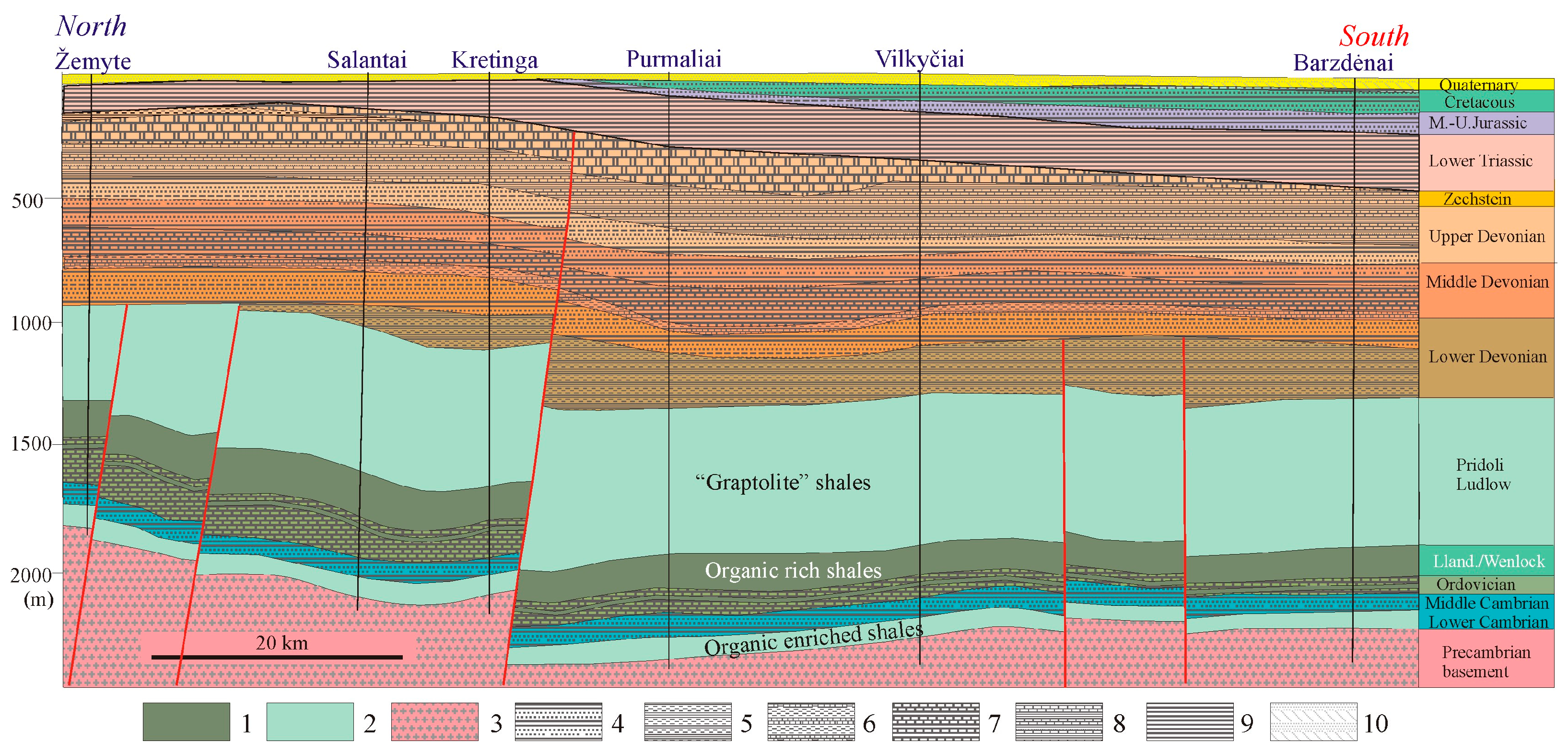
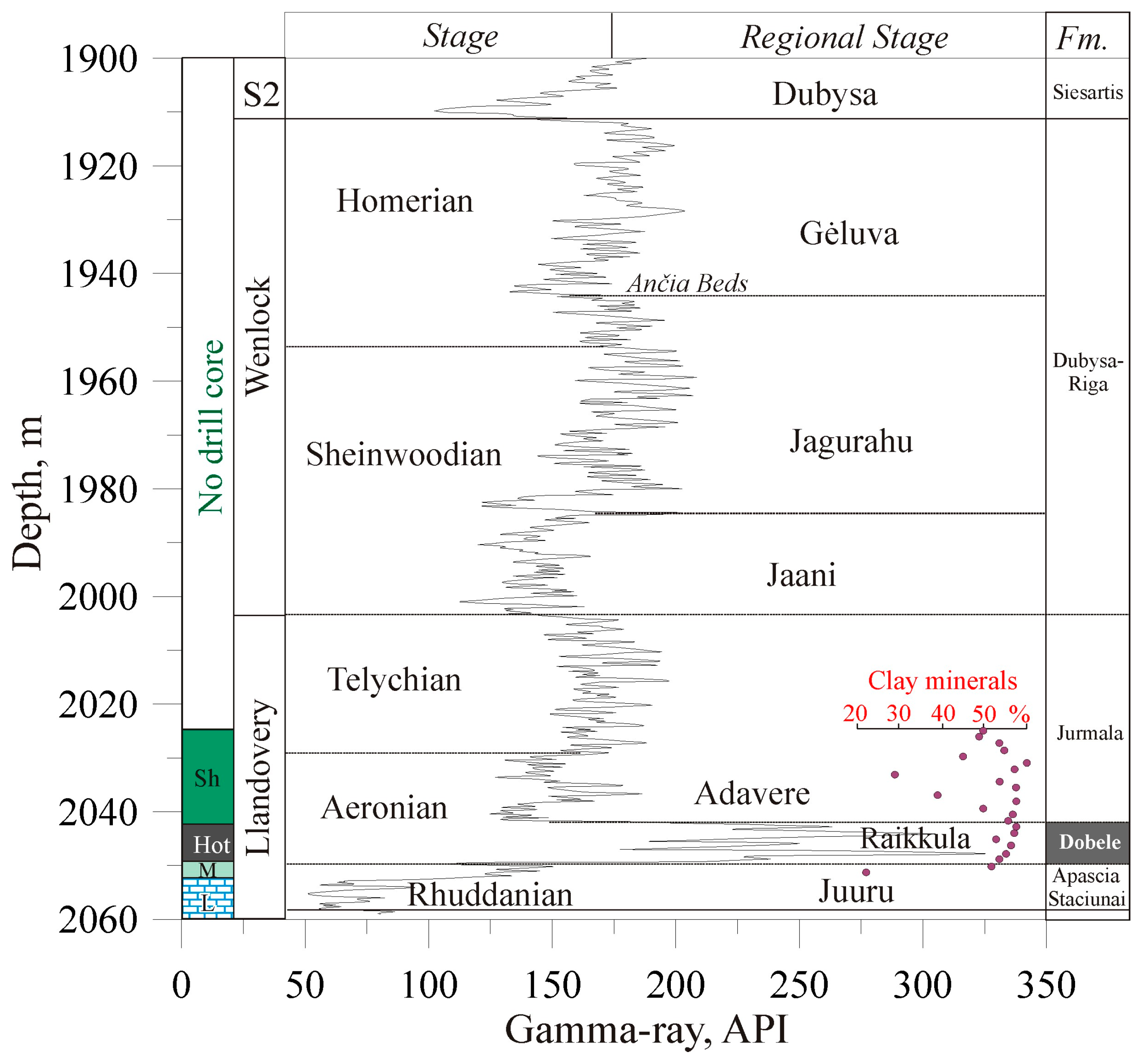
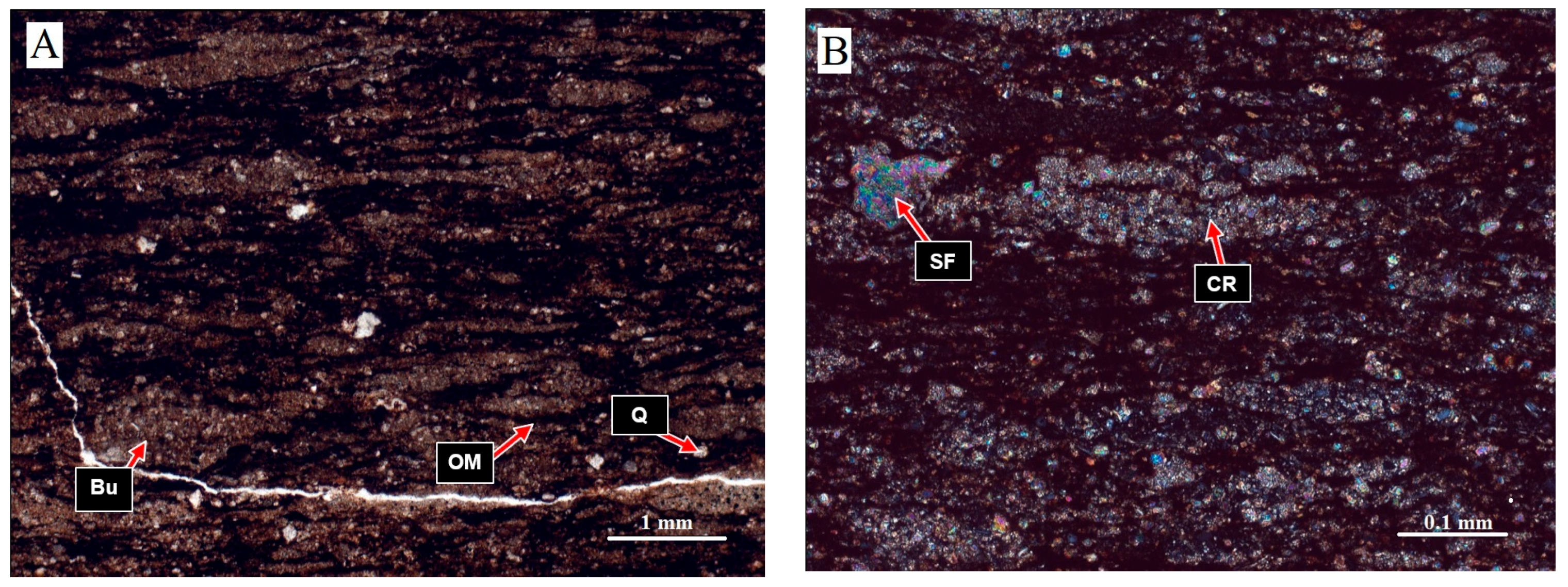
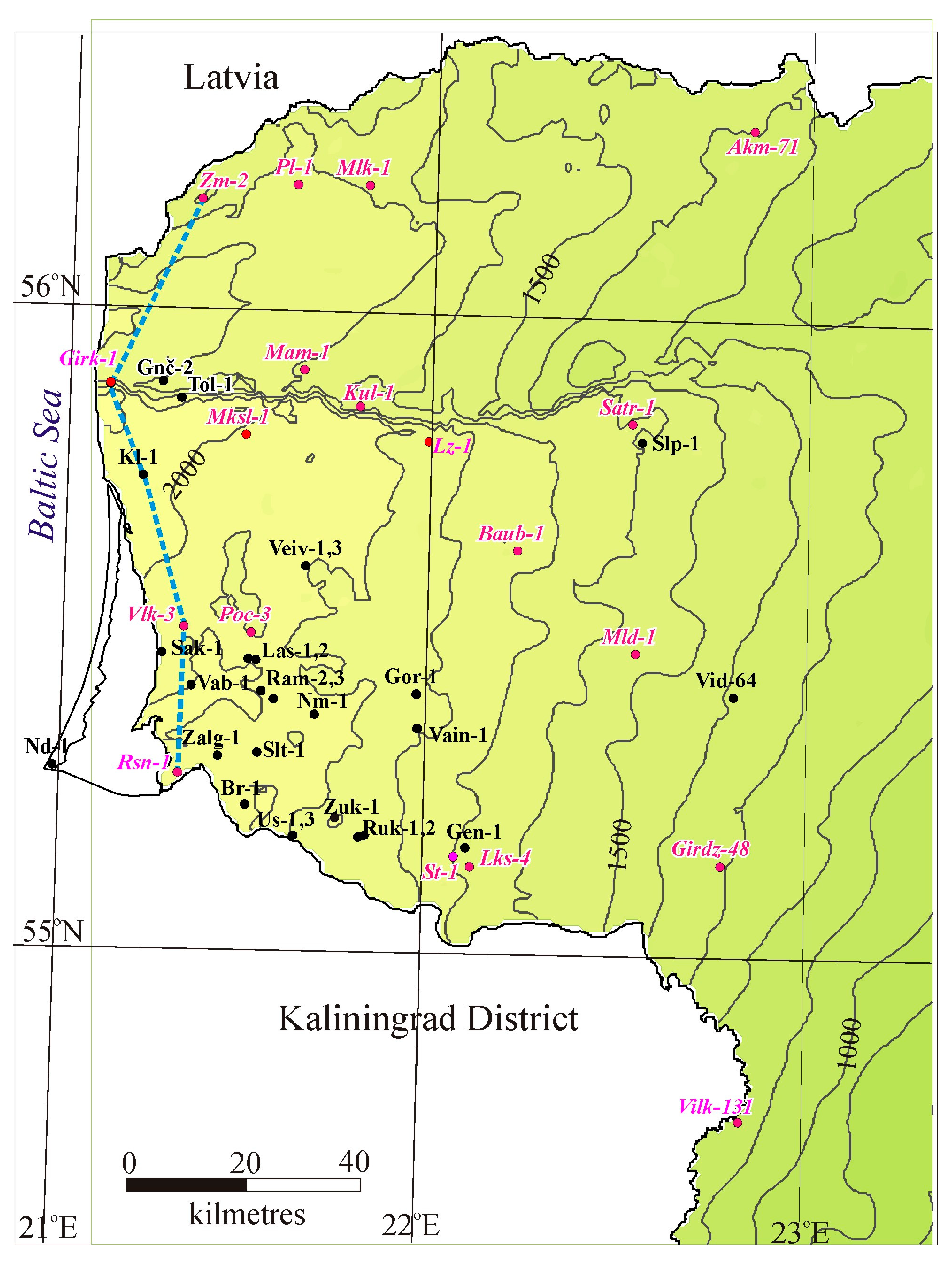
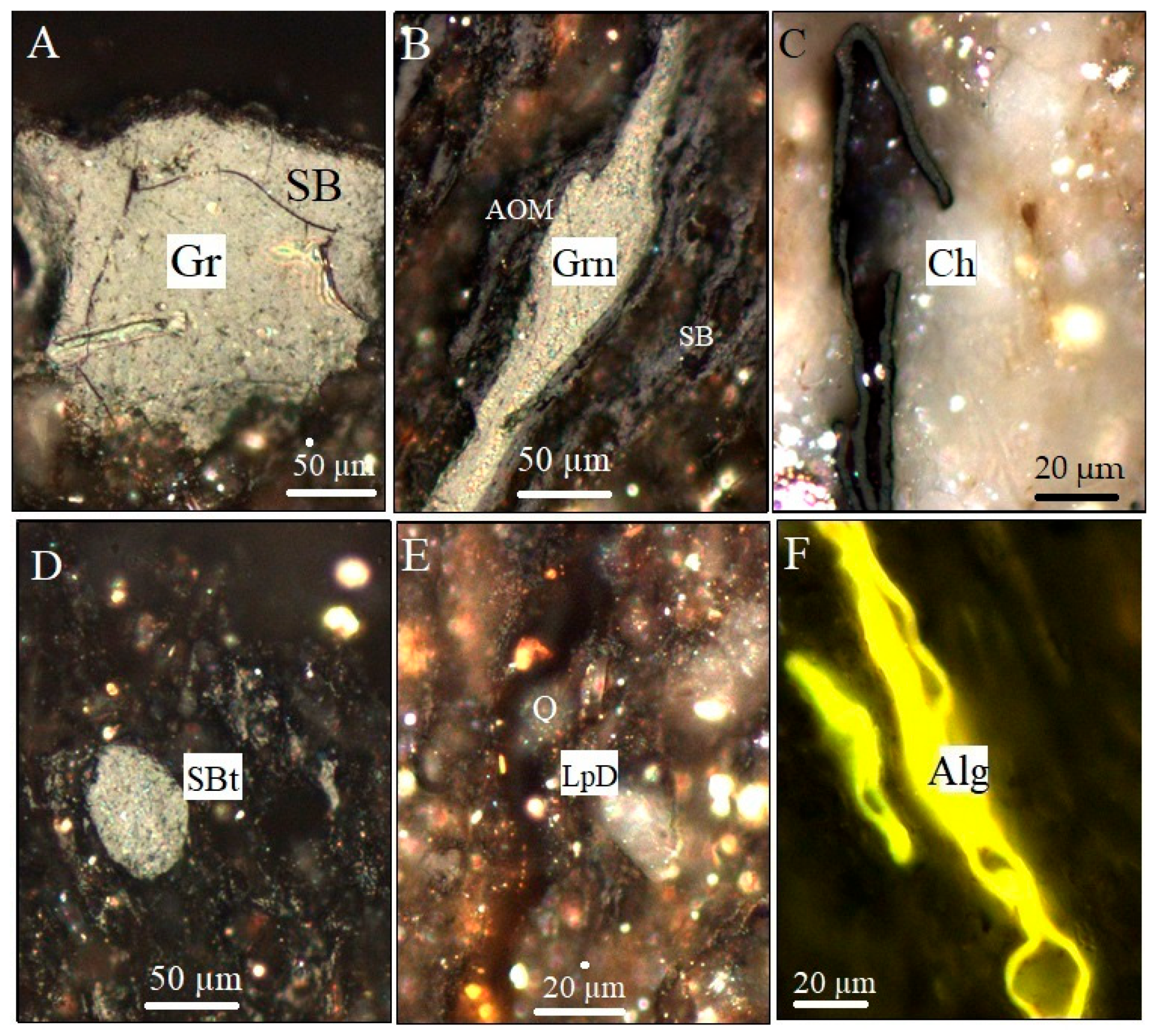
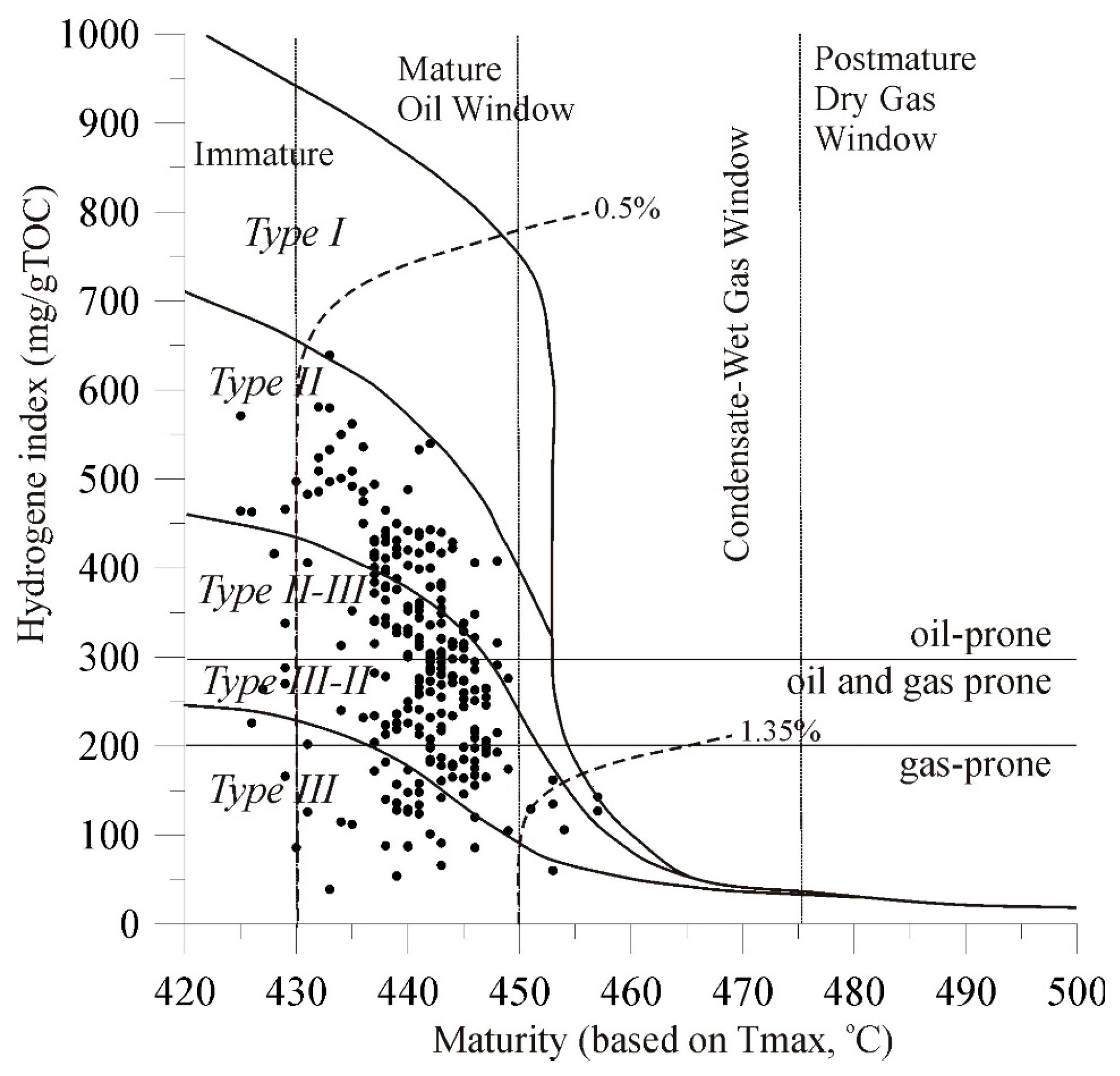

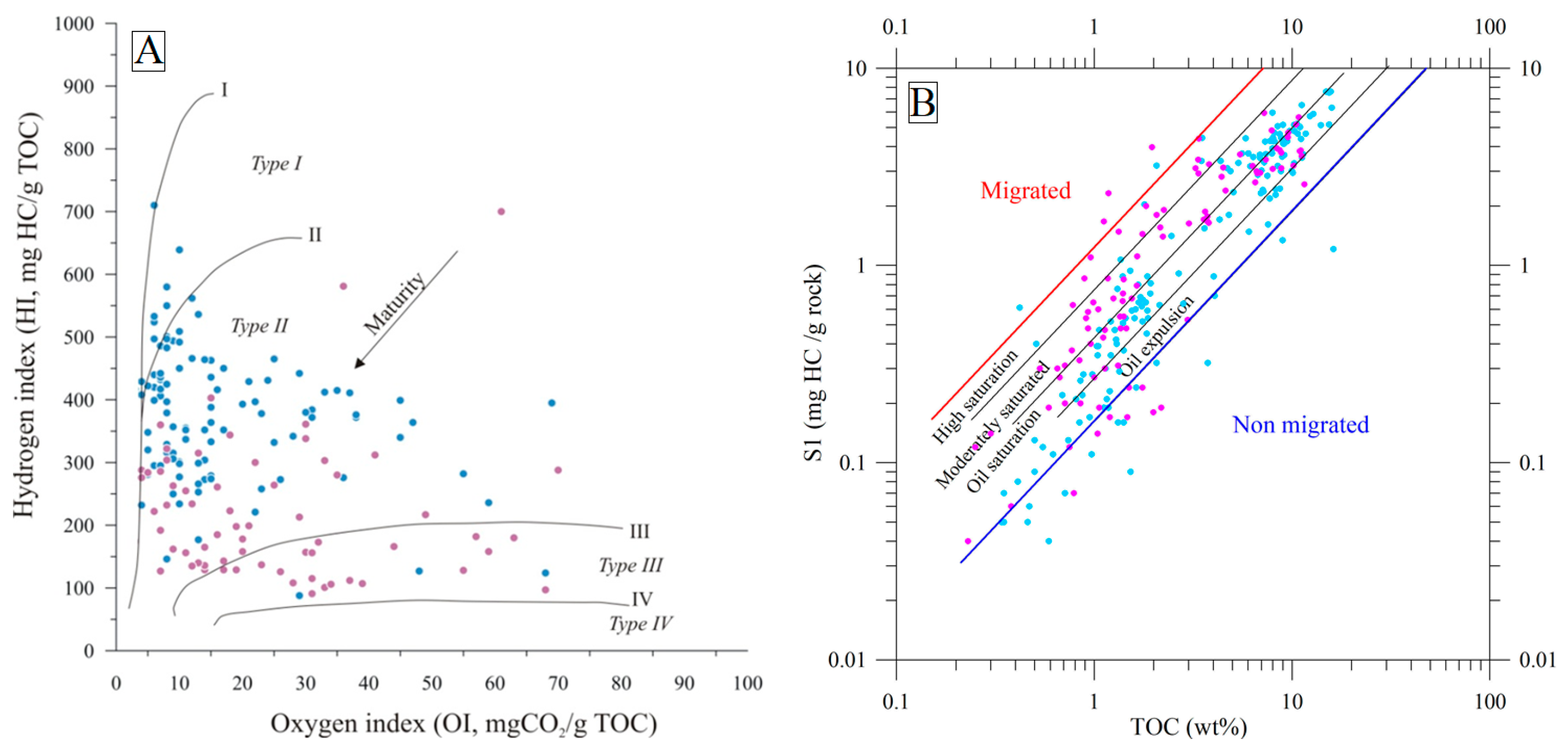
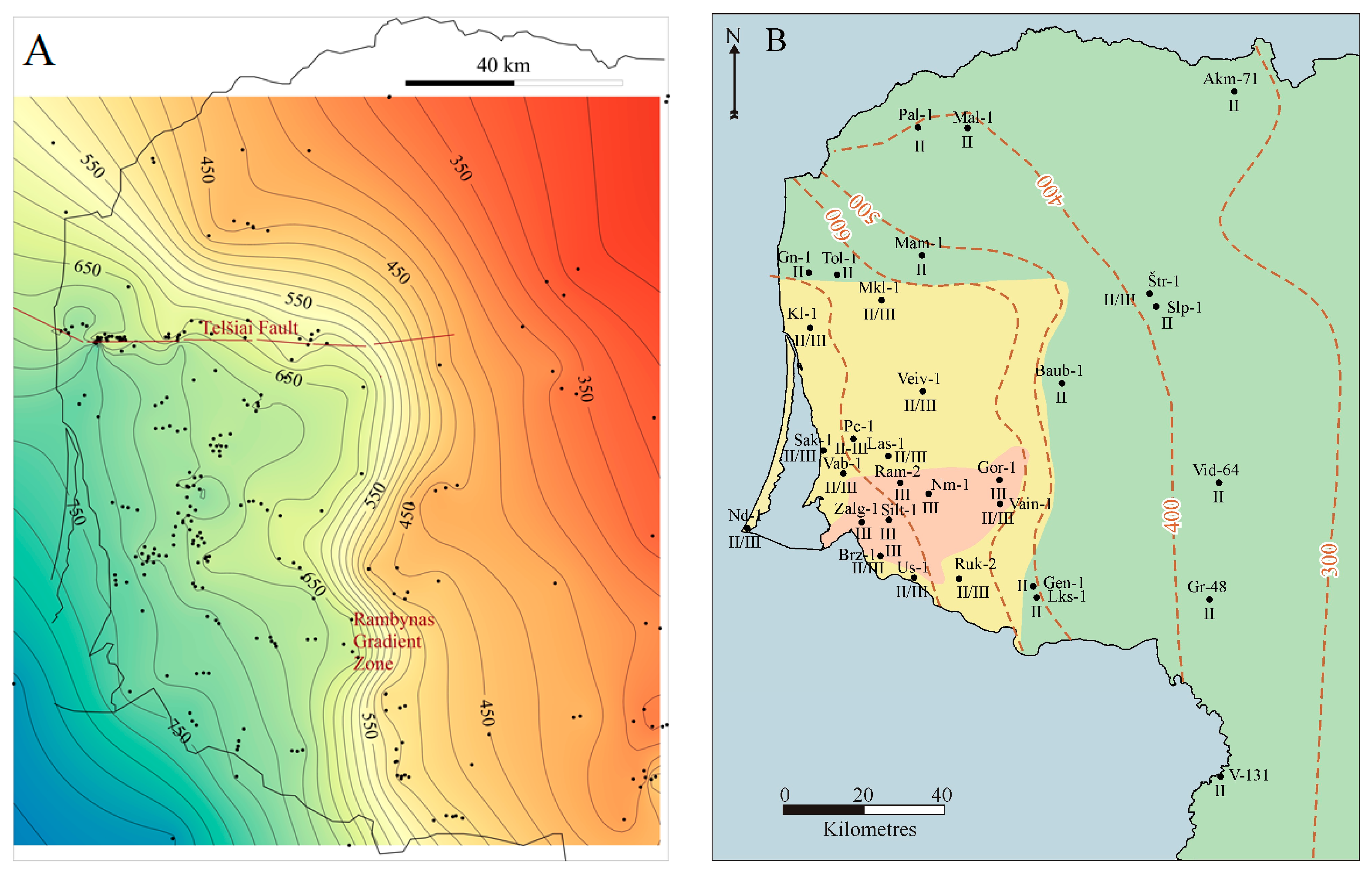

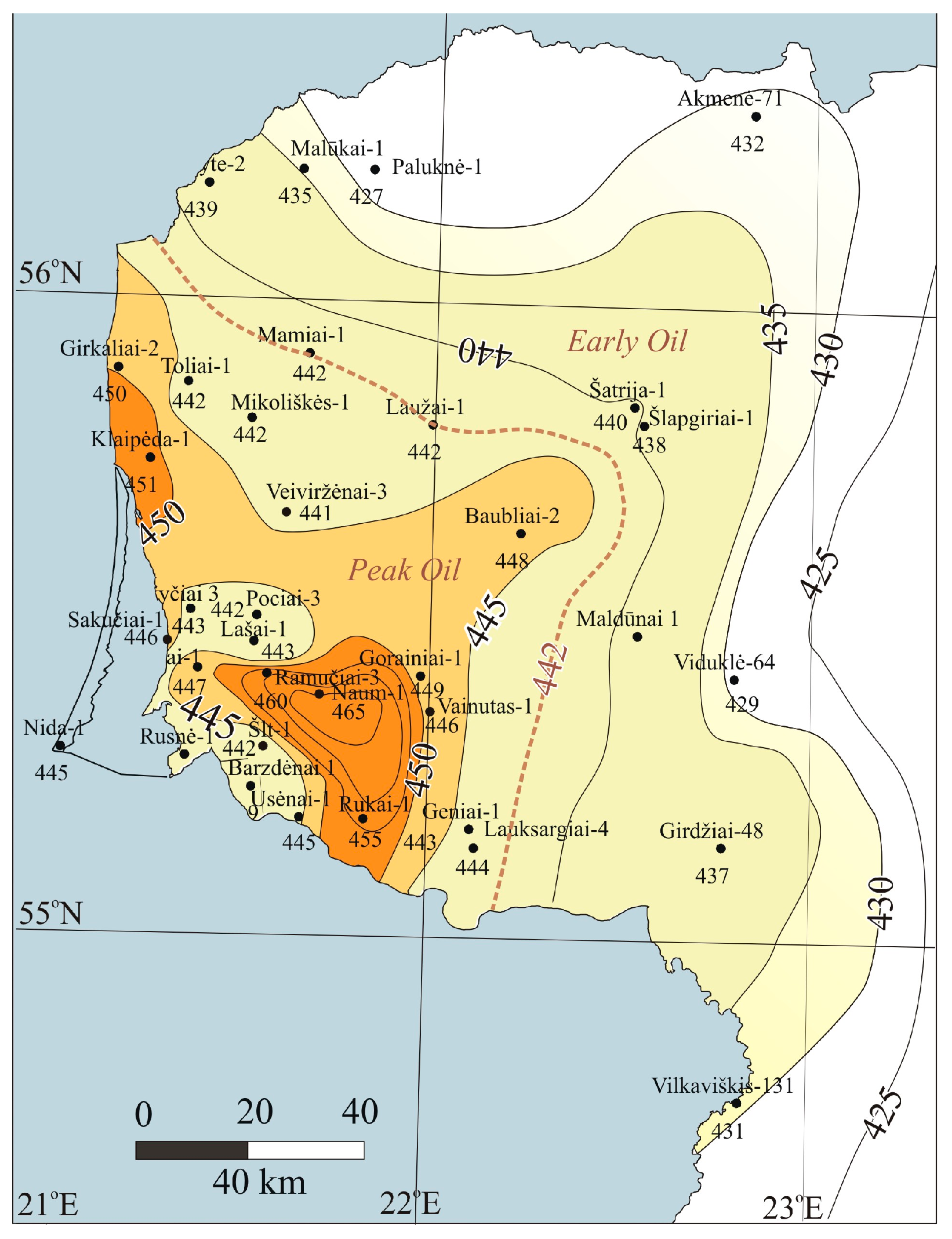
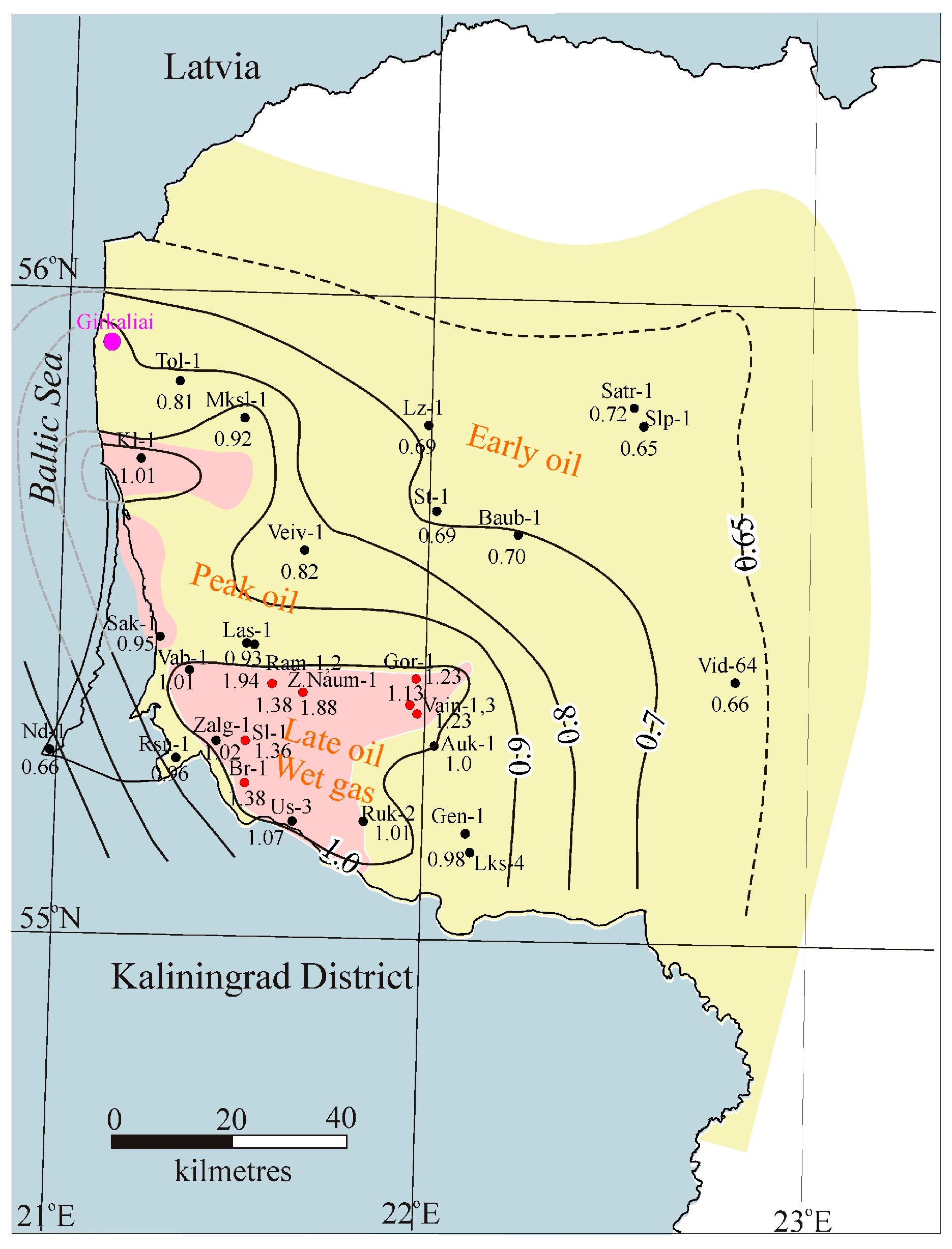

Disclaimer/Publisher’s Note: The statements, opinions and data contained in all publications are solely those of the individual author(s) and contributor(s) and not of MDPI and/or the editor(s). MDPI and/or the editor(s) disclaim responsibility for any injury to people or property resulting from any ideas, methods, instructions or products referred to in the content. |
© 2025 by the authors. Licensee MDPI, Basel, Switzerland. This article is an open access article distributed under the terms and conditions of the Creative Commons Attribution (CC BY) license (https://creativecommons.org/licenses/by/4.0/).
Share and Cite
Šliaupa, S.; Lazauskienė, J.; Šliaupienė, R. Thermal Maturity of the Silurian “Hot” Shales and Correlation with the Present Geothermal Variations in West Lithuania, Baltic Basin. Minerals 2025, 15, 539. https://doi.org/10.3390/min15050539
Šliaupa S, Lazauskienė J, Šliaupienė R. Thermal Maturity of the Silurian “Hot” Shales and Correlation with the Present Geothermal Variations in West Lithuania, Baltic Basin. Minerals. 2025; 15(5):539. https://doi.org/10.3390/min15050539
Chicago/Turabian StyleŠliaupa, Saulius, Jurga Lazauskienė, and Rasa Šliaupienė. 2025. "Thermal Maturity of the Silurian “Hot” Shales and Correlation with the Present Geothermal Variations in West Lithuania, Baltic Basin" Minerals 15, no. 5: 539. https://doi.org/10.3390/min15050539
APA StyleŠliaupa, S., Lazauskienė, J., & Šliaupienė, R. (2025). Thermal Maturity of the Silurian “Hot” Shales and Correlation with the Present Geothermal Variations in West Lithuania, Baltic Basin. Minerals, 15(5), 539. https://doi.org/10.3390/min15050539





